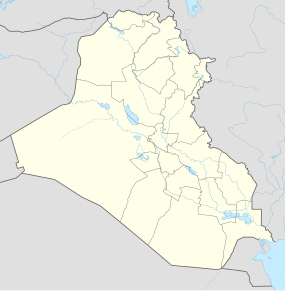Jarmo

The Neolithic village of Jarmo in Iraqi Kurdistan, 1954
|
|
| Location | Chamchamal, Kirkuk Province, Iraq |
|---|---|
| Region | Mesopotamia |
| Coordinates | 35°32′56″N 44°57′1″E / 35.54889°N 44.95028°ECoordinates: 35°32′56″N 44°57′1″E / 35.54889°N 44.95028°E |
| Type | Settlement |
| Area | 12,000 to 16,000 m2 (170,000 sq ft) |
| History | |
| Founded | Approximately 7090 BC |
| Abandoned | Approximately 4950 BC |
| Periods | Neolithic |
Jarmo (Qal'at Jarmo) is a prehistoric archeological site located in Southern Kurdistan (northern Iraq) on the foothills. It lies in the Zagros Mountains at an altitude of 800 m above sea-level in a belt of oak and pistachio woodlands. Excavations revealed that Jarmo was an agricultural community dating back to 7090 BCE. It was broadly contemporary with such other important Neolithic sites such as Jericho in the southern Levant and Çatal Hüyük in Anatolia.
The site was originally discovered by the Iraqi Directorate of Antiquities in 1940, and later became known to archaeologist Robert Braidwood from the University of Chicago Oriental Institute. At the time, he was looking for suitable places to research the origins of the Neolithic Revolution. Braidwood worked as part of the Iraq-Jarmo programme for three seasons, those of 1948, 1950–51 and 1954–55; a fourth campaign, to be carried out in 1958-59 did not come about because of the 14 July Revolution. During the excavations in Jarmo in 1954-55, Braidwood used a multidisciplinary approach for the first time, in an attempt to refine the research methods and clarify the origin of the domestication of plants and animals. Among his team were a geologist, Herbert Wright, a palaeo-botanist, Hans Helbaek, an expert in pottery and radio-carbon dating, Frederic Mason, and a zoologist, Charles Reed, as well as a number of archaeologists. The interdisciplinary method was subsequently used in all serious field work in archaeology.
The excavations exposed a small village, covering an area of 12,000 to 16,000 m², and which has been dated (by carbon-14) to 7090 BC, for the oldest levels, to 4950 BC for the most recent. The entire site consists of twelve levels. Jarmo appears to be two older, permanent Neolithic settlements and, approximately, contemporary with Jericho or the Neolithic stage of Shanidar. The high point is likely to have been between 6,200 and 5,800 BC. This small village consisted of some twenty five houses, with adobe walls and sun-dried mud roofs, which rested on stone foundations, with a simple floor plan dug from the earth. These dwellings were frequently repaired or rebuilt. In all, about 150 people lived in the village, which was clearly a permanent settlement. In the earlier phases there is a preponderance of objects made from stone, silex- using older styles- and obsidian. The use of this latter material, obtained from the area of Lake Van, 200 miles away, suggests that some form of organized trade already existed, as does the presence of ornamental shells from the Persian Gulf. In the oldest level baskets have been found, waterproofed with pitch, which is readily available in the area.
...
Wikipedia

